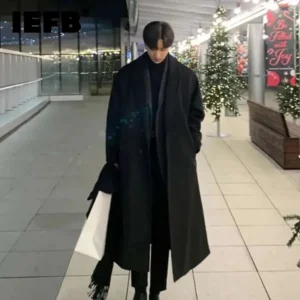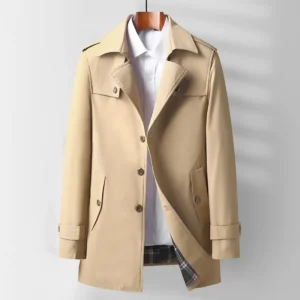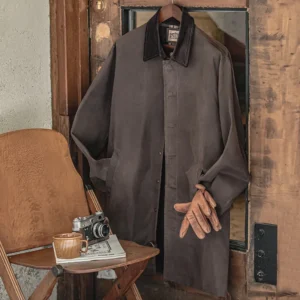Introduction: Why the Right Dress Coat Elevates Your Formal Appearance
A dress coat is far more than just an outer layer for warmth. Unlike casual jackets or everyday outerwear, a proper dress coat is crafted specifically to complement and enhance formal attire. It’s meticulously designed with structured shoulders, refined fabrics, and elegant details that casual coats simply don’t possess.
Consider this: at any formal event, your coat is both the first and last garment others will see. When you arrive at a black-tie gala or a winter wedding, your coat creates that crucial first impression. Similarly, when bidding farewell, it’s your coat that leaves the lasting image in people’s minds. This dual role makes selecting the right men’s dress coat an essential consideration for any formal occasion.
The perfect dress coat does more than just keep you warm—it completes your ensemble with sophistication and intention. Think of iconic moments in classic cinema where the gentleman’s entrance is defined by his impeccable overcoat, or how royalty and dignitaries use formal outerwear to project authority and refinement.
In this guide, we’ll explore the various types of dress coats suitable for different events, provide detailed advice on selecting the perfect coat for your needs, and share expert styling tips to ensure you make the right impression at your next formal gathering.
Understanding Men’s Dress Coat Types for Every Event
Navigating the world of formal outerwear requires understanding how different coat styles correspond to various levels of formality and occasion types. Each dress coat category has distinct characteristics that make it more or less appropriate for specific events.
When selecting the ideal coat, consider not only the formality of the event but also practical elements like weather conditions and how the coat will interact with your formal attire underneath. The perfect coat should enhance rather than distract from your overall appearance, with choosing the right coat length being particularly crucial for maintaining proper proportions.
Let’s explore the primary dress coat options and their ideal settings.
The Overcoat: The Quintessential Formal Option
The overcoat stands as the pinnacle of formal outerwear, characterized by:
- Full length (typically extending to the knee or below)
- Substantial weight and structure that drapes cleanly over formal attire
- High-quality wool or cashmere construction for warmth and elegance
- Clean lines and minimal extraneous details
Traditional men’s overcoats are perfectly suited for the most formal occasions, including black-tie events, opera nights, formal business functions, and winter weddings. Their longer length not only provides superior warmth but creates a distinguished silhouette that enhances formal attire.
The most classic version is the Chesterfield variation, which features a clean, minimalist front with no belt, often with a velvet collar that adds a touch of refinement. When worn over a tuxedo or formal suit, a well-fitted overcoat creates an unmistakably polished appearance that signals attention to detail and understanding of formal dress codes.
The Topcoat: Versatile Elegance for Semi-Formal Events
The topcoat offers a slightly less formal but equally refined alternative to the overcoat, distinguished by:
- Lighter weight construction suitable for transitional seasons
- Mid-thigh to knee length, generally shorter than overcoats
- Less structured shoulders and body for greater ease of movement
- Typically crafted from lighter wool, cashmere, or wool blends
Men’s topcoats excel in business formal settings, daytime ceremonies, and semi-formal events where a full overcoat might feel too substantial. Their more versatile nature makes them ideal for professional environments and occasions where you need to balance formality with practicality.
The lighter construction allows for comfortable wear in various temperatures, making the topcoat a practical investment for year-round use. A well-chosen topcoat pairs beautifully with business suits and smart separates, offering refined protection without the gravitas of a full-length overcoat.
The Chesterfield: Classic Refinement with Distinguished Details
The Chesterfield coat represents timeless formality with distinctive features:
- Single-breasted design with a fly front (concealed buttons)
- Velvet collar in contrasting color (traditionally black)
- Clean, straight lines without a belt
- Mid-calf length for traditional versions
- Often crafted from dark wool in herringbone or solid patterns
This style traces its origins to Victorian England and remains a symbol of refined taste. The Chesterfield is particularly well-suited for traditional formal events, including weddings, theater outings, and business formal occasions where classical elegance is appreciated.
The signature velvet collar evolved from practical origins (protecting the fabric from hair pomade) to become a distinguished design element. Today’s versions maintain this heritage detail while incorporating modern tailoring for contemporary relevance.
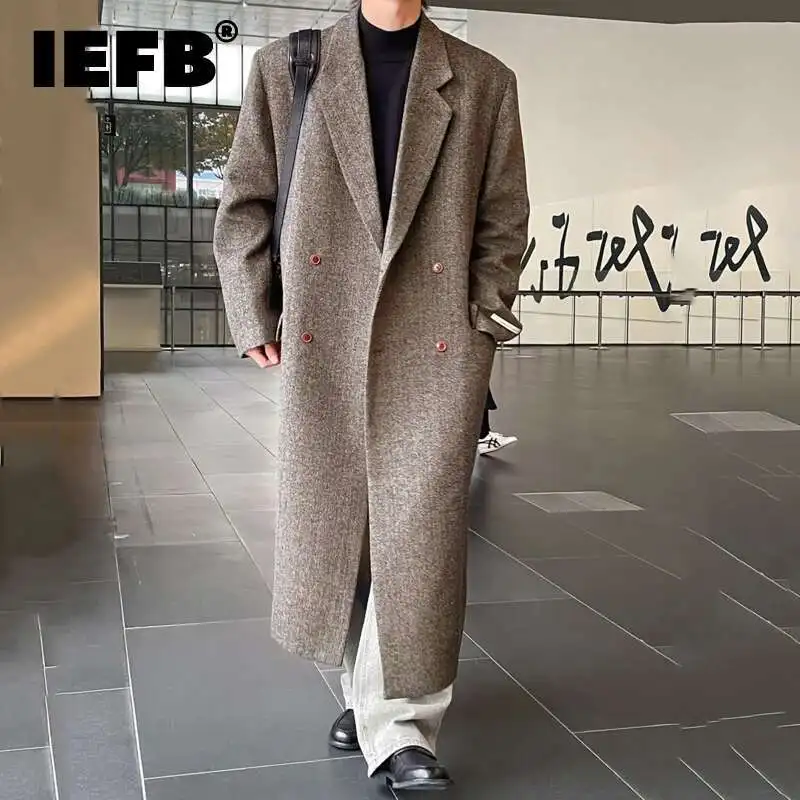
The subtle texture of a herringbone coat adds visual interest while remaining appropriately formal for dressed-up occasions. This pattern is particularly effective in Chesterfield styles, offering classic refinement with a touch of character.
The Covert Coat: Sophisticated Versatility
The covert coat offers distinctive British heritage styling with:
- Twill or covert cloth construction (tightly woven fabric with excellent durability)
- Four rows of stitching near the hem and on the cuffs (a signature detail)
- Fly front concealing the buttons for a clean appearance
- Typically knee length or slightly above
- Often in fawn, tan, or olive tones (though navy and charcoal options exist for more formal settings)
Originally designed for horseback riding and country pursuits, the covert coat has evolved into a respected option for business and smart-casual events. Its heritage gives it a refined character that works well for less restrictive dress codes while maintaining sufficient formality for business settings.
The balance of formality and practicality makes this coat particularly valuable for professional men who need outerwear that transitions seamlessly between different environments. Understanding men’s coat length guidelines is especially important with this style, as proper proportions enhance its sophisticated appeal.
The Trench Coat: Weather-Ready Formal Option
The trench coat offers practical elegance with:
- Double-breasted front with ten buttons
- Belted waist for a defined silhouette
- Storm flaps, epaulets, and wrist straps (military-inspired details)
- Water-resistant properties for inclement weather
- Mid-calf to knee length
While traditionally less formal than other dress coats, a well-chosen trench can be appropriate for many formal occasions, particularly in rainy or unpredictable weather. For maximum formality, select versions in darker colors (navy or black) with minimal embellishments and a proper fit that accommodates formal attire.
The key to elevating a trench coat for formal wear lies in its execution—premium materials, impeccable tailoring, and sophisticated color choice transform this practical garment into a worthy companion for dress clothes. Wool or wool-blend trench coats in particular offer increased formality compared to cotton versions.
Key Considerations for Selecting the Perfect Dress Coat
Finding your ideal dress coat requires weighing several critical factors to ensure both appropriateness for formal occasions and practical functionality. The perfect coat strikes a balance between adherence to dress codes, personal comfort, and style preference.
The following sections will guide you through the decision-making process, considering event type, material quality, proper fit, style elements, and color selection. These considerations work together to determine which classic men’s overcoats for formal wear will best serve your needs.
Matching Coat Formality to the Event Type
Your coat selection should directly correspond to the formality level of the event:
Black-tie and white-tie events: These demand the highest formality. Choose a full-length overcoat in black, midnight navy, or charcoal. Velvet-collared Chesterfields and clean-lined wool overcoats are ideal. Ensure immaculate tailoring and premium materials.
Weddings and formal celebrations: Consider both your role and the time of day. For evening weddings or if you’re in the wedding party, choose an overcoat similar to black-tie standards. For daytime or as a guest, a topcoat or Chesterfield in navy or charcoal works well.
Business formal and corporate functions: Topcoats and covert coats excel here, offering professional refinement without appearing overly formal. Dark colors remain preferable, though navy, charcoal, and even camel can be appropriate.
Semi-formal and cocktail gatherings: This allows slightly more flexibility. Well-tailored topcoats or trench coats in wool can provide the right balance of polish and approachability.
Galas and cultural events: Consider the venue and season. Historic venues and evening events generally call for more traditional formal overcoats, while contemporary settings might accommodate more modern interpretations.
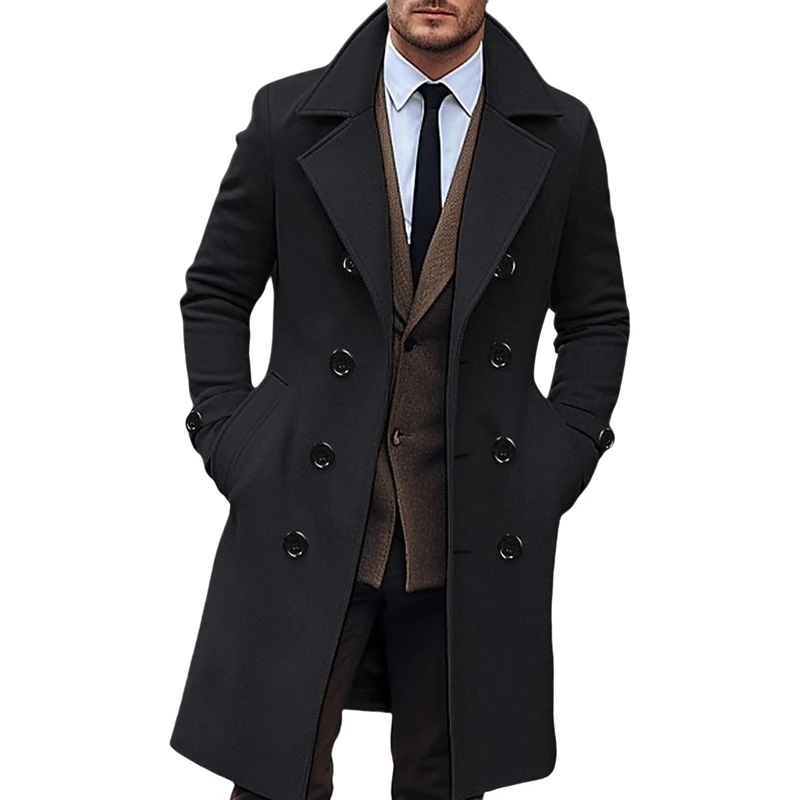
Premium Materials That Define Quality Dress Coats
The fabric of your dress coat significantly impacts both its appearance and performance:
Pure Cashmere: Offers unmatched softness, lightweight warmth, and elegant drape. Ideal for the most formal occasions but requires careful maintenance. Men’s cashmere overcoats provide luxurious comfort with a refined appearance.
Wool/Cashmere Blends: Deliver excellent warmth with enhanced durability compared to pure cashmere. These blends offer nearly the same elegance with better resilience.
Pure Wool (Merino, Melton): High-quality wool provides excellent structure, warmth, and weather resistance. Melton wool, with its tight weave and smooth finish, is particularly well-suited for formal coats.
Lining Materials: Quality formal coats feature cupro, viscose, or silk linings that facilitate easy wearing over suits while adding warmth and durability.
| Material | Warmth | Durability | Drape | Formality |
|---|---|---|---|---|
| Pure Cashmere | Excellent | Moderate | Exceptional | Highest |
| Wool/Cashmere Blend | Very Good | Good | Very Good | High |
| Pure Wool (Melton) | Very Good | Excellent | Good | High |
| Wool/Synthetic Blend | Good | Very Good | Moderate | Moderate |
Beyond the fabric itself, construction elements like hand-stitched details, canvas interlining (rather than fused), and horn or corozo buttons distinguish premium dress coats.
Perfect Fit: Essential Tailoring Guidelines
A proper fit elevates any dress coat, regardless of style or material:
Shoulders: The coat’s shoulders should align with or extend just slightly beyond your natural shoulders to accommodate a suit jacket underneath. Bunching or pulling indicates poor fit.
Sleeve Length: Ideally, coat sleeves should end at the base of your thumb when arms are relaxed, allowing 1/4 to 1/2 inch of suit jacket sleeve to show (which itself should reveal 1/4 to 1/2 inch of shirt cuff).
Body: When buttoned, the coat should allow enough room for layers without excess fabric. You should be able to comfortably cross your arms without restriction.
Length: Following perfect coat length for height guidelines is crucial. For formal overcoats, the hem typically falls between the knee and mid-calf. Topcoats generally end just above or at the knee.
Collar: The coat collar should rest against your suit jacket collar without gapping or bunching when fully buttoned.
If purchasing off-the-rack, focus on correct shoulder fit and sleeve length, as these are the most difficult and expensive elements to alter. Body suppression and sleeve narrowing are more reasonable alterations for perfecting fit.
Style Elements That Define Dress Coat Sophistication
Small details significantly impact a coat’s formality and character:
Lapel Styles: Peak lapels signal the highest formality, particularly on double-breasted coats. Notch lapels are versatile and widely acceptable for most formal occasions. Ulster lapels (with their broader cut designed to be worn turned up) are less formal but practical for inclement weather.
Closure Types: Double-breasted overcoats project authority and traditional formality. Single-breasted styles with concealed plackets (fly fronts) offer clean, minimalist elegance appropriate for most formal settings.
Pocket Styles: Jetted pockets (with no flaps) provide the cleanest, most formal appearance. Flap pockets are acceptable on most formal coats but should lie flat. Patch pockets significantly reduce formality and are generally avoided on true dress coats.
Vents: Single back vents or no vents create the cleanest lines for formal coats. Double vents offer more movement while maintaining a structured appearance.
Buttons: Horn, mother-of-pearl, or high-quality corozo buttons elevate a coat’s refinement. They should be securely attached with quality thread and proportional to the coat’s scale.
Strategic Color Selection for Maximum Versatility
Color choice significantly impacts a coat’s formality and versatility:
Black: The most formal option, ideal for evening events and black-tie occasions. Black overcoats offer maximum versatility for formal environments.
Navy: Nearly as formal as black but with slightly more versatility. Navy complements virtually all suit colors and works for both day and evening events.
Charcoal: Highly formal with excellent versatility. Less severe than black while maintaining sufficient formality for most dress occasions.
Camel: Less formal but still appropriate for business settings and daytime formal events. Offers distinctive elegance when impeccably tailored.
Patterns: Subtle patterns like herringbone or faint windowpane can be appropriate for less strict formal occasions while adding visual interest. Keep patterns refined and low-contrast for formal settings.
For maximum versatility, a navy or charcoal coat will complement most formal attire from tuxedos to business suits. When paired with black-tie attire, darker colors create a more cohesive appearance.
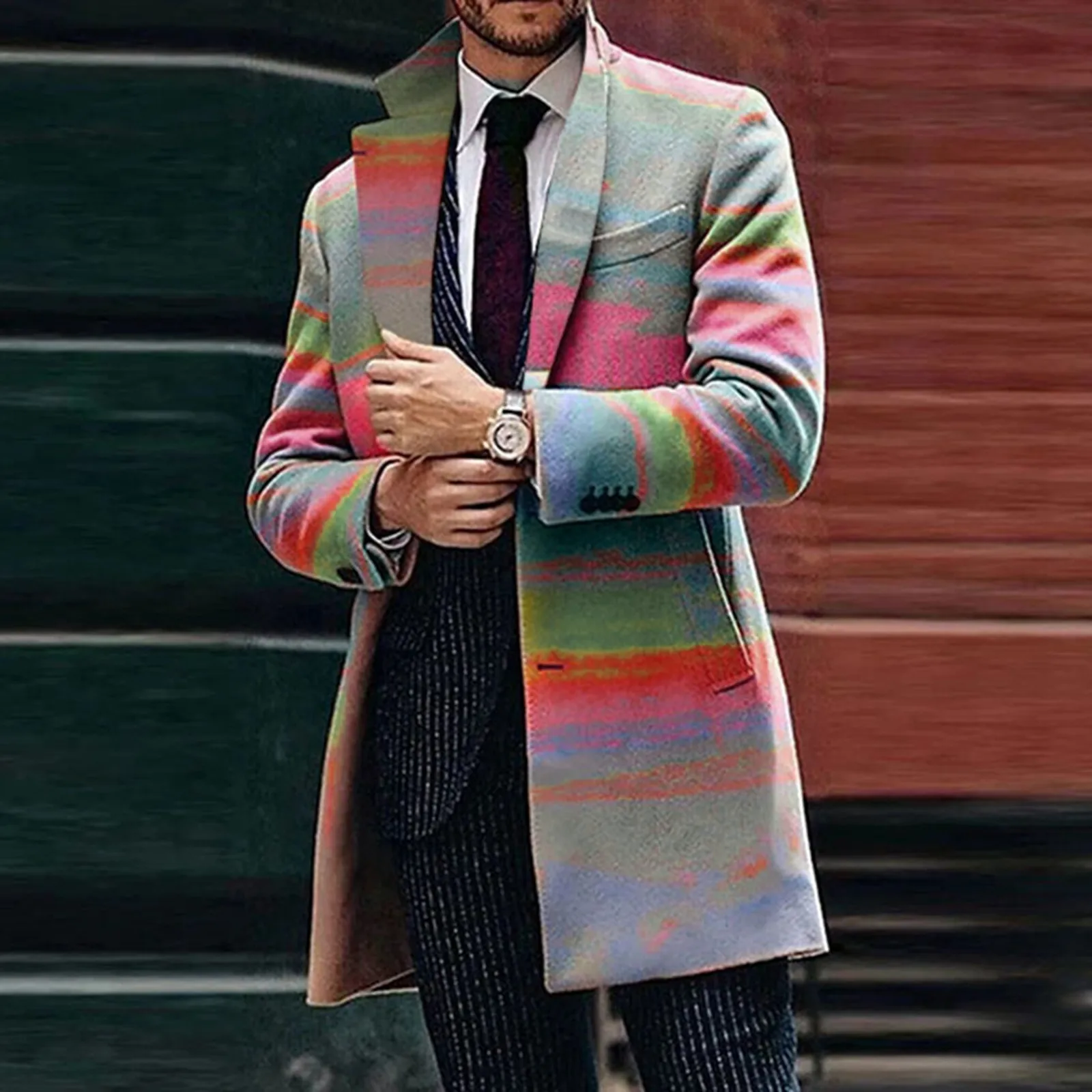
Top Recommendations: Exemplary Dress Coats for Various Events
When investing in a formal coat, quality and appropriateness for your specific needs should guide your decision. The following recommendations highlight exceptional options for different formal contexts, balancing traditional requirements with practical considerations.
Each category represents coats that excel in specific formal environments, though many quality options offer versatility across multiple settings. Choosing the perfect dress coat for formal events requires understanding these distinctions.
The Ultimate Black-Tie Dress Coat
For the highest formal occasions, these features define the ideal coat:
- Full-length silhouette (typically mid-calf) for maximum formality and coverage
- Pure wool or cashmere construction in black or midnight navy
- Peak lapels that complement formal evening wear
- Clean front with concealed closure (fly front)
- Minimal detailing beyond perfect tailoring and luxurious fabric
This coat style pairs seamlessly with tuxedos and formal evening attire. The investment in a dedicated black-tie coat is justified for those who regularly attend formal evening events, as it creates an unmistakably elegant silhouette that enhances rather than detracts from formal attire.
While the initial investment may be significant, the timeless styling ensures decades of relevance when properly cared for, making it a true wardrobe cornerstone.
Mens Cashmere Overcoat, Mens Hooded Winter Coat, Mens Wool Blend Coat
Price range: $128.72 through $139.68 Select options This product has multiple variants. The options may be chosen on the product pageMens Black Overcoat, Mens Black Wool Coat, Mens Wool Overcoat
$339.18 Select options This product has multiple variants. The options may be chosen on the product pageMens Grey Overcoat, Mens Wool Blend Coat, Mens Wool Overcoat
$201.28 Select options This product has multiple variants. The options may be chosen on the product pageMens Herringbone Coat, Mens Long Overcoat, Mens Wool Overcoat
Price range: $197.16 through $203.69 Select options This product has multiple variants. The options may be chosen on the product pageMens Long Overcoat, Mens Topcoats
Price range: $189.40 through $196.88 Select options This product has multiple variants. The options may be chosen on the product pageMens Long Overcoat, Mens Tweed Coat
Price range: $397.49 through $409.96 Select options This product has multiple variants. The options may be chosen on the product page
The Essential Business & Semi-Formal Dress Coat
For versatile elegance across multiple dress codes:
- Mid-length design (typically knee-length) for versatility
- Wool or wool-blend construction with sufficient weight for structure
- Notch lapels that complement both suits and smart-casual attire
- Subtle details that enhance versatility without compromising refinement
- Dark neutral coloration (navy or charcoal) for maximum pairing options
This category represents perhaps the most practical investment for most men, offering appropriate formality for business settings and many ceremonial occasions while maintaining everyday usability. A quality coat in this category adapts beautifully to varied situations, from important client meetings to evening theater outings.
Look for thoughtful details like functioning cuff buttons and quality lining that facilitate comfortable wearing over multiple layers. These features enhance both practical function and refined appearance.
Quality Investment: The Heritage Dress Coat
For those seeking exceptional craftsmanship and timeless appeal:
- Traditional construction methods including hand-padded collars and lapels
- Natural shoulder expression with minimal padding
- Hand-sewn buttonholes and interior details
- Premium materials that develop character with age
- Thoughtful design elements drawn from historical precedent
Heritage dress coats represent the pinnacle of outerwear craftsmanship, often utilizing techniques refined over generations. These garments feature details rarely found in mainstream production: fully canvassed construction (rather than fused), hand-finished edges, and materials selected for both immediate beauty and long-term development.
The investment in such a coat is justified by extraordinary longevity, with many heritage pieces serving their owners for decades while developing unique character. For formal events where subtle quality distinctions matter, these coats quietly communicate discernment and appreciation for craftsmanship.
Expert Styling: Pairing Dress Coats with Event Attire
Creating a harmonious relationship between your dress coat and the formal attire beneath requires attention to proportion, color coordination, and overall aesthetic cohesion. The coat should enhance rather than compete with your suit or tuxedo, creating a unified appearance.
The following sections provide practical guidance for achieving sophisticated coat-and-formal-wear combinations across various dress codes and occasions.
Creating Harmony Between Coat and Formal Suit
For seamless integration of coat and suit:
Ensure proportional balance by matching the coat’s structure to your suit’s silhouette. A structured suit calls for a similarly structured coat, while softer-shouldered suits pair well with slightly less rigid coats.
Coordinate color families thoughtfully. Navy, charcoal, and black coats offer nearly universal compatibility, while camel and lighter tones require more careful suit pairing.
Pay attention to fabric textures. Smooth-finished coats generally pair best with worsted wool suits, while subtly textured coats can complement flannel or tweed suits effectively.
Maintain consistent formality levels between coat and suit. A cashmere overcoat elevates a standard wool suit, while a casual coat undermines even the finest tailoring.
Avoid common mistakes like selecting a coat too tight to fit comfortably over a suit jacket or choosing drastically different silhouettes between coat and suit. Following proper men’s coat length style guidance ensures the proportions work harmoniously.
Elevated Elegance: Pairing with Black Tie Attire
Black tie ensembles demand particular attention to outerwear selection:
Traditional evening formality calls for a clean-lined overcoat in black or midnight navy, with peak lapels that echo those on your tuxedo jacket.
Consider texture contrast between the matte finish of barathea wool tuxedo fabric and a slightly more substantial coat texture for visual interest while maintaining formality.
When wearing formal scarves with black tie, white or ivory silk creates the most traditional and elegant appearance. The scarf should be arranged simply to maintain clean lines.
For modern black tie interpretations, a precisely tailored topcoat with minimal details can offer a contemporary alternative to the classic full-length overcoat.
The coat should frame the tuxedo rather than dominate it. Upon arrival, when the coat is removed, the transition should reveal a perfectly presented formal ensemble without wrinkles or distortion caused by inappropriate outerwear.
Essential Finishing Touches: Accessories and Details
The right accessories complete and elevate a formal coat ensemble:
Formal Scarves: For black-tie events, silk or cashmere in solid colors (white, ivory, black) arranged in a simple horizontal fold projects refined elegance. For business formal, patterned silk or cashmere adds tasteful personality while maintaining professionalism.
Gloves: Leather gloves in colors matching or darker than your coat provide classic refinement. For maximum formality, black leather gloves with a simple design and minimal stitching are ideal. Brown leather should coordinate with other leather accessories.
Pocket Squares: When visible above your coat pocket, these should coordinate with (but not match exactly) your scarf or other accessories. Simple white linen offers universal appropriateness.
Umbrellas: For formal settings, choose long umbrellas with wooden or leather handles in black or navy. The canopy should be solid colored and coordinate with your outerwear.
These details should appear intentional rather than afterthoughts. Quality accessories properly deployed enhance the overall impression of refinement and attention to detail.
Care and Maintenance for Lasting Quality
Proper maintenance ensures your dress coat remains an elegant companion for years to come:
Store coats on broad, wooden hangers that support the shoulders properly. Cedar hangers offer the added benefit of repelling moths and absorbing moisture.
Use breathable garment bags when storing during off-seasons. Avoid plastic covers which trap moisture and can promote mildew.
Allow coats to rest between wearings. Ideally, rotate between multiple coats rather than wearing the same one daily.
Brush coats regularly with a soft clothes brush to remove surface dust and debris before it settles into the fabric.
Address spots and spills promptly with appropriate spot cleaning methods. Blot (don’t rub) moisture, and consult professional cleaners for stubborn stains.
Dry thoroughly before storing if your coat gets damp. Hang in a well-ventilated area away from direct heat sources.
Seek professional dry cleaning only when necessary (typically once per season with regular wear). Excessive cleaning can damage natural fibers and remove beneficial oils.
Check for loose buttons or small tears regularly and address them immediately before they worsen.
Professional maintenance, like restitching loose seams or replacing worn linings, can significantly extend a quality coat’s lifespan, making it a truly long-term investment.
Understanding Quality and Value in Dress Coats
When investing in a dress coat, understanding the elements that contribute to quality helps justify the often substantial price difference between premium and average options:
Full-canvas construction, where the coat’s internal structure is created with canvas that molds to your body over time, offers superior drape and longevity compared to fused construction, which uses glue to attach interfacing.
Hand-sewn elements, particularly at stress points like lapels, armholes, and buttonholes, provide both strength and subtle elegance that machine stitching cannot replicate.
Natural fiber content (wool, cashmere, camel hair) typically indicates higher quality than coats with significant synthetic content, offering better temperature regulation and aging characteristics.
Origin of materials can significantly impact quality, with certain regions producing particularly exceptional wool and cashmere.
Consider cost-per-wear when evaluating value. A $1,000 coat worn 30 times per year for 10 years costs just $3.33 per wearing—often less expensive long-term than replacing lower-quality coats every few years.
The Metro Cloak approach focuses on identifying these quality markers and curating coats that deliver exceptional value through superior materials, construction, and design that transcends short-term trends.
Frequently Asked Questions About Men’s Dress Coats
What exactly distinguishes an overcoat from a topcoat?
Overcoats are typically heavier, longer (usually knee-length or below), and designed for cold weather protection. Topcoats are lighter weight, often shorter (typically mid-thigh to knee), and intended for milder temperatures or transitional seasons.
Is a trench coat appropriate for black-tie events?
A high-quality trench in black or navy can be appropriate when weather necessitates it, particularly if the coat features minimal embellishments and a clean silhouette. However, a traditional wool overcoat remains the more formal and preferred option when possible.
How should I layer a dress coat over a suit without looking bulky?
Choose a coat specifically sized to accommodate tailored clothing beneath—typically your regular size or one size up depending on the cut. The coat’s shoulders should extend just slightly beyond your suit jacket shoulders, and the chest and waist should allow comfortable closure without strain or excess fabric.
What’s the most versatile dress coat color for multiple formal occasions?
Navy offers exceptional versatility, appearing appropriate for both daytime and evening events while complementing virtually any suit color. Charcoal provides similar versatility with slightly less formality than black.
If I can only purchase one formal coat, which style should I choose?
A single-breasted wool topcoat in navy or charcoal represents the most versatile investment, offering appropriate formality for most business and social occasions while providing practical functionality across multiple seasons.





